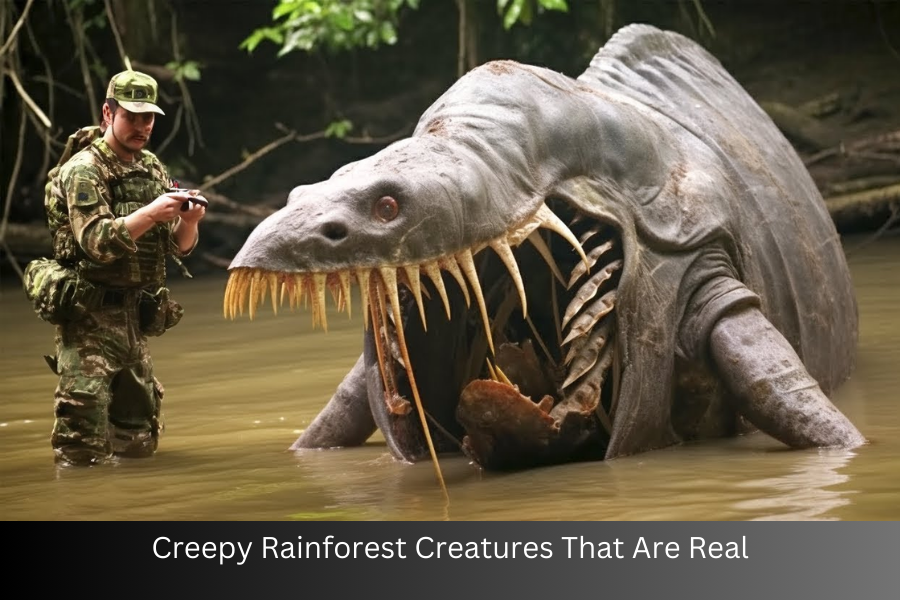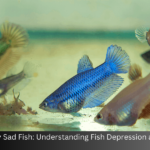Introduction
Rainforests are known for their dense vegetation, vibrant biodiversity, and mysterious beauty. But these lush habitats also harbor some of the creepiest creatures on Earth. The creatures that dwell in these ecosystems often possess eerie characteristics that make them the stuff of nightmares. From venomous insects to massive predators, the rainforest is home to some truly unsettling and fascinating animals. Let’s dive into the world of creepy rainforest creatures that are real and discover what makes them so remarkable and terrifying.
Hoatzin: The Stinky Bird
The Hoatzin, also known as the “stink bird,” is a bizarre and unsettling bird native to the rainforests of South America. Its appearance is equally odd, with a spiky crest on its head and a body that resembles a prehistoric bird. However, it’s not just the Hoatzin’s looks that are creepy—it also has a foul odor. This is due to its digestive system, which is similar to that of cows and ferments the plants it consumes. This fermentation process results in a strong, musty smell, hence the bird’s nickname. But what makes the Hoatzin even more eerie is its unique parenting. When threatened, Hoatzin chicks will fall from the tree, spreading their wings and making a terrifying cry. These adaptations make the Hoatzin one of the creepiest creatures in the rainforest
Bullet Ant: The Painful Predator
The Bullet Ant, known for delivering one of the most excruciating stings in the insect world, is another rainforest resident that sends chills down the spine. The sting of this small insect is said to feel like being shot, and it can last for over 24 hours. The pain is so intense that it has been described as a deep, burning sensation. The Bullet Ant is often found in the rainforests of South America, where it is a formidable creature in the insect world. Its venom can cause paralysis, and while fatalities are rare, the sting can result in debilitating pain. Native tribes have even used Bullet Ant stings in initiation rituals, where young men are stung repeatedly as a rite of passage. The Bullet Ant’s aggressive behavior and intense sting make it one of the creepiest and most feared insects in the rainforest
Brazilian Wandering Spider: The Nighttime Hunter
The Brazilian Wandering Spider, also known as the armed spider, is a member of one of the most venomous spider families in the world Creepy Rainforest Creatures That Are Real. Unlike many spiders, it does not build webs but instead actively hunts for prey during the night. Its venomous bite can cause intense pain, paralysis, and even death if untreated. These spiders are found in the rainforests of Brazil, where they prefer to hide in dark, damp places like rotting logs and piles of leaves. What makes the Brazilian Wandering Spider so creepy is its aggression. It will not hesitate to attack if it feels threatened, and its massive size only adds to its terrifying reputation. If you were to encounter one, it would be a truly unsettling experience
Wiki
| Creature | Habitat | Size | Diet | Danger to Humans | Unique Feature |
| Hoatzin | South American Rainforests | Up to 26 inches | Leaves, fruits, flowers | No direct danger, but has a strong odor | Ferments food in its stomach like cows, producing a foul odor |
| Bullet Ant | South American Rainforests | 1.2 inches | Insects, larvae, and fruit | Extremely painful sting, lasts 24 hours | Known for its excruciating sting that feels like being shot |
| Brazilian Wandering Spider | Brazilian Rainforests | Up to 6 inches | Insects, small vertebrates | Venomous bite can be fatal if untreated | Known for wandering, hunting actively rather than making webs |
| Electric Eel | Amazon River, South America | Up to 10 feet | Fish, small mammals | Dangerous electric shock capable of paralysis or death | Can generate up to 600 volts of electricity for self-defense and hunting |
| Candiru | Amazon River | Up to 2 inches | Blood of larger fish | Rare but infamous for parasitic behavior (entering human urethras) | Small fish capable of latching onto and feeding on blood |
| Green Anaconda | Amazon and Orinoco Basins | Up to 30 feet | Mammals, birds, reptiles | Can constrict and kill large prey | One of the heaviest snakes in the world, can hunt large animals |
| Arapaima | Amazon River | Up to 10 feet | Fish, birds, mammals | No direct danger to humans | Capable of leaping out of the water and preying on a variety of animals |
| Giant Otter | Amazon River and Tributaries | Up to 6 feet | Fish, crabs, small caimans | Aggressive hunting behavior, but not a threat to humans | Cooperative hunting and loud vocalizations |
| Vampire Bat | Central and South America | 3 to 4 inches | Blood of mammals and birds | Can transmit diseases through bites | Feeds on blood, often lapping it up from small cuts in prey |
| Amazonian Giant Leech | Amazon River and Wetlands | Up to 18 inches | Blood of fish, reptiles, mammals | Dangerous if not removed carefully | Can latch onto prey and drain blood for hours |
Electric Eel: The Living Battery
The Electric Eel is a creature that lives up to its name. Found in the murky waters of the Amazon River, this eel-like fish can generate an electric charge powerful enough to stun or even kill its prey. The Electric Eel is capable of producing up to 600 volts of electricity, which it uses for hunting and self-defense. The eel can deliver a series of shocks that cause paralysis, allowing it to immobilize its prey before devouring it. What makes the Electric Eel even more terrifying is its ability to hunt in complete darkness, using electricity to sense its surroundings. Its ability to deliver powerful electric shocks makes it a creepy and deadly predator in the rainforest
Candiru: The Parasitic Fish
One of the most infamous creatures of the Amazon rainforest, the Candiru, is a small parasitic fish that is feared for its creepy and grotesque behavior. The Candiru is known for its ability to enter the urethra of humans and larger animals when they urinate in the river. Though actual cases of these fish causing harm to humans are rare, the legend has made them one of the creepiest creatures in the rainforest. The fish uses its spiny body to latch onto the gills of larger fish, feeding on their blood. Its parasitic behavior, combined with the disturbing legend surrounding it, makes the Candiru a source of both fascination and fear
Green Anaconda: The Massive Serpent
The Green Anaconda is one of the largest and heaviest snakes in the world Creepy Rainforest Creatures That Are Real, making it one of the most fearsome creatures of the rainforest. Growing up to 30 feet in length and weighing as much as 550 pounds, this massive snake is capable of taking down large animals such as deer, capybaras, and even caimans. The Green Anaconda does not rely on venom to subdue its prey—instead, it constricts its victims, suffocating them before swallowing them whole. The sheer size and strength of the Green Anaconda, combined with its ability to move silently through the water, make it a terrifying predator in the rainforest. Its presence in the murky waters of the Amazon River is enough to make anyone think twice before wading in
Arapaima: The Giant Fish
The Arapaima is one of the largest fish in the world Creepy Rainforest Creatures That Are Real, capable of reaching lengths of up to 10 feet. Native to the Amazon River, this giant fish is both fascinating and creepy due to its size and feeding habits. The Arapaima hunts near the surface of the water and is capable of leaping out of the water to catch its prey. It is an opportunistic predator, feeding on fish, birds, and even small mammals. The Arapaima’s ability to leap from the water, coupled with its massive size, makes it an intimidating presence in the rainforest. Its sleek, armored body and sharp teeth contribute to its status as one of the creepiest creatures in the Amazon
Giant Otter: The River Wolf
The Giant Otter, also known as the “river wolf,” is a large and highly social carnivore found in the rivers and lakes of the Amazon Basin. It can grow up to 6 feet long and is capable of hunting in packs. While otters are typically seen as cute, the Giant Otter is a fierce predator. It feeds on a variety of animals, including fish, crabs, and even small caimans. Its cooperative hunting tactics and its ability to take on animals much larger than itself make the Giant Otter a fearsome predator in its environment. Although it is not dangerous to humans, its aggressive hunting methods and loud vocalizations add to its creepy reputation
Vampire Bat: The Bloodsucker
Vampire Bats are nocturnal creatures that feed on the blood of mammals, birds, and sometimes humans. These bats use their sharp teeth to make small incisions in their prey’s skin, then lap up the blood as it flows. While they do not typically drain their prey dry, the idea of a bat feeding on blood is enough to make many people shudder. Found in the rainforests of Central and South America, the Vampire Bat is a creepy creature that thrives in the darkness. Its ability to fly silently, combined with its blood-sucking behavior, makes it a creepy and unsettling predator
Amazonian Giant Leech: The Bloodsucker of the Waters
The Amazonian Giant Leech is a massive leech species that can grow up to 18 inches long. Unlike its smaller relatives, the Amazonian Giant Leech has a voracious appetite for blood, often feeding on large animals like fish, reptiles, and even mammals. It latches onto its prey using sharp teeth and can remain attached for hours, draining its victim of blood. These leeches are particularly creepy because of their sheer size and the way they remain hidden in the muddy waters of the Amazon, waiting for unsuspecting animals to come near. Their ability to remain submerged for long periods makes them a dangerous and frightening predator
Conclusion
The rainforest is a vibrant ecosystem teeming with life, but some of its creatures are truly creepy. Whether it’s the venomous sting of the Bullet Ant, the shocking power of the Electric Eel, or the bloodsucking habits of the Vampire Bat, these real-life creatures are as terrifying as they are fascinating. The diversity of the rainforest ecosystem has led to the evolution of some of the most bizarre and spine-chilling animals on the planet, each perfectly adapted to its environment.
From the eerie glow of bioluminescent fungi to the massive Green Anaconda lurking in the shadows, these creatures remind us of the raw power and mystery of nature. While many of these creatures are dangerous, they also play vital roles in their habitats, maintaining balance within the rainforest ecosystem. Though creepy, they are essential to the intricate web of life that makes the rainforest one of the most unique and biodiverse places on Earth.
FAQs
1. Are the creepy creatures in the rainforest dangerous to humans?
Some of the creatures discussed, like the Brazilian Wandering Spider and Bullet Ant, are venomous and can cause severe pain or injury to humans. However, most of the animals in the rainforest are not aggressive toward humans unless provoked. Always exercise caution when exploring these environments.
2. What is the most dangerous animal in the rainforest?
The Green Anaconda and Brazilian Wandering Spider are among the most dangerous creatures in the rainforest. The Green Anaconda, being capable of constricting large prey, poses a significant threat, while the Brazilian Wandering Spider’s venom can lead to serious complications if bitten.
3. How do the creepy creatures of the rainforest survive in their environment?
These creatures have developed unique adaptations to survive in the rainforest. For example, the Electric Eel uses electricity for hunting and self-defense, while the Hoatzin bird has a digestive system similar to a cow’s to break down tough plant matter. These adaptations help them thrive in an environment that is often hostile and challenging.
4. Are there any myths surrounding rainforest creatures?
Yes, many rainforest creatures are shrouded in myths and legends. For example, the Candiru fish is infamous for being said to swim up human urethras when people urinate in the water. While the occurrence of this is rare, the myth adds to the creature’s eerie reputation.
5. How can I protect myself from dangerous creatures in the rainforest?
When traveling in the rainforest, it’s important to wear protective clothing, such as long sleeves and pants, to minimize exposure to insects and plants. Additionally, be cautious of venomous animals by staying alert and avoiding unnecessary contact. It’s also wise to consult local guides who are familiar with the environment.
Explore the latest news and updates on Play Hop



